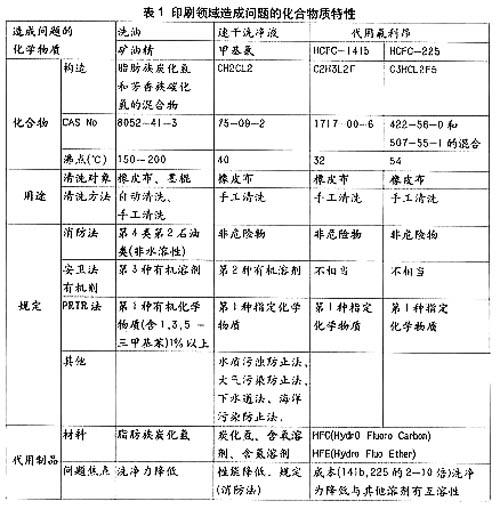The use of cleaners for offset printing has been used extensively in print production, and the environmental issues and safety of operators have received increasing attention. This article addresses the current state of the cleaners for offset printing and the direction of improvement, as well as some of the focus on it.
First, the status of the use of cleaners in offset printing
1. Range of use
(1) Blanket.
Every time you change the plate, you should wash it once. Because of the moderate dryness required, mineral spirits are mostly used.
(2) Ink roller.
Color change must be cleaned, compared to the blanket, the frequency is lower, better drying, often using lamp oil or mineral spirits.
(3) Others.
1 Print cleaners (print plate cleaning, mineral spirits and water emulsions);
2 blanket recovery agent (recessed depression, rubber swelling solvent, liquid products, gelatinous products, methyl chloride);
3 Maintenance materials (automatic feeder, delivery machine, impression cylinder, ink fountain, cleaning squeegee, etc.).
2. cleaning method
(1) Automatic cleaning. In recent years, most printing machines have automated the cleaning of blankets, ink rollers, and impression cylinders. With regard to blankets, the use of nonwovens has increased. There are existing types of non-woven fabrics and cleaning liquids and products that have previously impregnated the cleaning liquid into the non-woven fabric.
(2) Manual cleaning. For applications such as non-automated printing presses and final processing after automatic cleaning, quick-drying solvents are used more frequently depending on operating conditions. 
Second, individual chemicals that cause problems in the printing field
1. Wash oil (mineral oil)
In the field of ink cleaning in the printing industry, the widely used wash oil (mineral oil) is designated as the third organic solvent in the Organic Solvent Intoxication Prevention Regulations of the Labor Safety and Health Act, and is also required to have ventilation facilities, health diagnosis, etc. material. Its components are hydrocarbon compounds with a boiling point of 150° C. to 200° C. obtained after the oil is branched, and have irritating effects on the skin and mucous membranes, anesthesia, and aromatic hydrocarbons that require toxicity. At the same time, 1.3.5-trimethylbenzene in the composition is a designated substance designated by the first chemical substance in the PRTR method. As an alternative to this mineral spirit, after discussion, in the aspect of labor safety and hygiene, the component of attention is aromatic hydrocarbon, so there is a replacement of petroleum hydrocarbon, a plant-derived hydrocarbon, and Higher fatty acid esters derived from vegetable oils. Hydrocarbons are classified from their structure into paraffins (chain saturated hydrocarbons), cyclic hydrocarbons (alkylcycloalkanes, cyclic saturated hydrocarbons), aromatic hydrocarbons (alkylbenzenes), but from the perspective of dearomatization Look, the study used paraffins, cyclic hydrocarbons, plant-derived hydrocarbons are turpentine oil, decadiene as a substitute for substitute materials, and higher fatty acid esters are recently used in soybean oil ink and other ingredients. The characteristics of their materials are shown in (Table 2).

Paraffins and cyclic hydrocarbons have been cited but have been delayed due to poor detergency (especially paraffin) and higher costs. Plant-derived hydrocarbons (turpentine, decadiene) are not yet out of the research stage from the standpoint of odor, regulations, and cost. At the same time, fatty acid esters derived from vegetable oils are subject to certain limitations in terms of use and method of use due to the problem of drying. In general, petroleum-derived naphthenic hydrocarbons are most effective as substitutes for washing oils and mineral spirits. Comparisons of the provisions and physical properties of cyclohydrocarbons and current products are shown in Table 3 (Table 3).

2. Methyl chloride
Methyl chloride is a chemical substance that is restricted by labor safety and hygiene laws, organic solvent poisoning prevention rules, the PRTR Law, and most laws and regulations, and is also regarded as a problematic chemical substance from the environmental point of view. On the contrary, the use in the printing industry tends to increase slightly due to its strong cleaning power, quick drying, flame retardancy, and low cost. Since the implementation of the PRTR law, it has been used within a certain range because it has not yet found a similar substitute.
Flame retardancy is a characteristic of organic halogenated solvents (chlorination, bromination). In the future, it can be said that there is no possibility that the new organic halogenated solvents can be developed and used safely. Therefore, in order to reduce the use of methyl chloride, its substitute materials must try to maintain the characteristics of methyl chloride. To achieve this goal, it depends on the efforts of the manufacturer and the understanding of the user (printing company). The characteristics of the materials that can be substituted for methyl chloride and their main points are shown in Table 4 below.

3. Alternative Freon (HCFC-141b, HCFC-225)
In the printing industry, alternative Freon is often added as an adjuvant to inhibit fires in cleaning agents. HCFC-141b, HCFC-225 should find its replacement as soon as possible according to the ozone layer protection law. These substitute Freons are compounds composed of carbon, hydrogen, fluorine, and chlorine. However, since chlorine is a component that destroys the ozone layer, chlorine-free fluorine-based solvents have been developed (HFC·Hydro Fluoro Carbon, HFE: Hydro Fluoro Ether. ).
The use of these fluorine-based solvents to maintain the function of the substitute Freon, but the current problem is that it is 2 to 10 times higher than the cost of alternative Freon, which is the main reason for delaying the spread.
Third, the conclusion
In the printing industry, ink cleaners have become indispensable materials. In the past, the selection of its solvents was mainly based on the operational efficiency and cost accounting. However, after the effects of chemical substances on the human body and the environment have been clarified, the industry should consider social requirements and use safe materials as a trend. To achieve this goal, it is necessary for the parties involved to take the initiative and work together. (Text/Ding Yi)
Capsule Sorting Polisher,Chinese Packing Machine,Packing Machine
Trustar Pharma & Packing Equipment Co., Ltd. , http://www.ruianpacking.com
